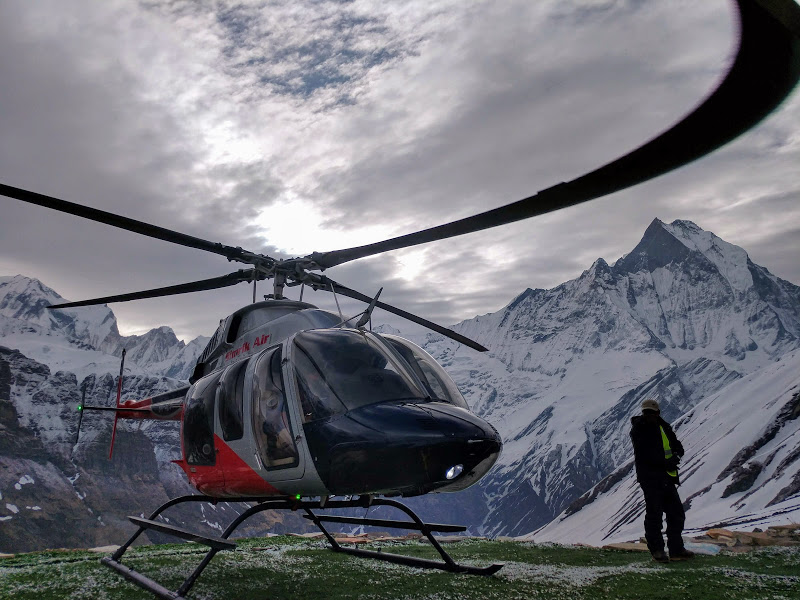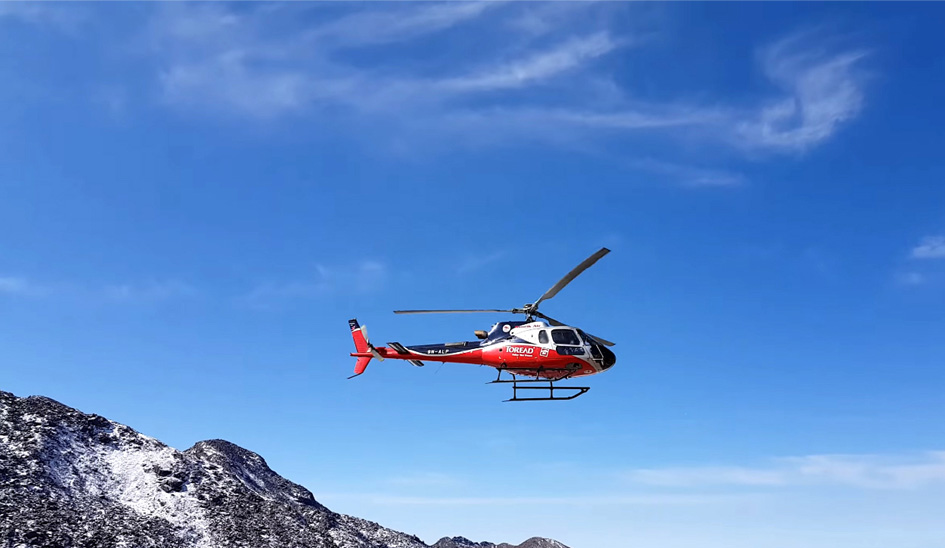Nestled among the awe-inspiring peaks of the Himalayas, Nepal is a dream destination for trekkers around the world. However, the allure of its breathtaking landscapes comes hand in hand with the challenging and unpredictable nature of its terrains. This is where helicopter rescue services become incredibly important. These lifesaving missions are designed to ensure trekkers' safety, providing a swift response in emergency situations when time is of the essence. Whether facing sudden weather changes or altitude sickness, from their vantage in the skies, helicopters play a critical role in ensuring that adventure seekers can explore with peace of mind.
The Challenges of Trekking in Nepal

Nepal, with its awe-inspiring landscapes and majestic Himalayas, has long been a trekker's paradise. Yet, the beauty of this region comes with significant challenges, making it both a dream and a daunting destination for adventurers. Understanding these challenges is essential for anyone planning a trek in Nepal, as it underscores the importance of preparation and safety measures, especially helicopter rescue services.
Unpredictable Weather Conditions
One of the most formidable challenges for trekkers in Nepal is the unpredictable weather. The Himalayas possess their own almost magical climate patterns that can shift rapidly. Imagine beginning your day under a dazzling blue sky, only to find yourself surrounded by ominous clouds and sudden snowfall by afternoon.
- Rain and Snow: In the summer months, the monsoon brings heavy rain, which can lead to slippery paths and landslides. In winter, there's the risk of snowstorms, which not only obscure trails but can also lead to dangerous avalanches.
- Fog and Blizzards: These common occurrences can drastically reduce visibility, making navigation treacherous. Even experienced guides can struggle when the trails disappear into the grey mist.
- Temperature Fluctuations: In high-altitude areas, temperatures can drop drastically at night, even after warm days. Without proper gear, hypothermia becomes a serious threat.
Such erratic weather conditions emphasize the need for a swift response during emergencies. This is where helicopter rescues become not just an option but a necessity for ensuring trekkers' safety amidst the weather's unpredictability.
Difficult Terrain and High Altitudes
Trekking in Nepal is not just about picturesque views and peaceful hikes. The terrain here is rugged and demanding, with trails carved into the side of mountains, crossing over passes, and often reaching altitudes that pose significant physiological challenges.
- Steep Trails and Rocky Paths: Trekkers often face steep inclines and descents that require endurance, strength, and agility. The rocky paths can be tough underfoot and occasionally treacherous, especially after rain.
- Navigating High Altitude: The trails often ascend above 3,000 meters (approximately 9,800 feet), where the air gets thin, and the risk of altitude sickness increases. Symptoms can range from headaches and dizziness to more severe conditions like High Altitude Pulmonary Edema (HAPE) and High Altitude Cerebral Edema (HACE).
- Glacier Crossings and Crevasses: In certain routes, especially those that are more remote and less traveled, there might be glacier crossings with hidden crevasses that pose hidden dangers.
These physical and environmental challenges demand not only individual preparedness but also backup plans like helicopter rescues that can offer immediate aid when conditions become hazardous or when a trekker finds themselves in distress.
Limited Accessibility in Remote Areas
Nepal’s beauty often lies in its remote and untouched areas. However, these secluded trails present unique challenges in terms of accessibility and infrastructure.
- Sparse Communication Facilities: In many remote areas, mobile network coverage is spotty at best or nonexistent, making communication with the outside world difficult during emergencies.
- Minimal Health Facilities: While urban centers and popular trails may have medical facilities or trekker aid posts, more isolated areas often lack the immediate medical support necessary in the event of an accident or severe illness.
- Rough and Narrow Pathways: The only way in and out of many trekking zones is by foot. Narrow trails can make transporting an injured trekker on foot risky and time-consuming.
The isolation of these remote areas highlights the vital role helicopter rescue services play. They can swiftly reach locations otherwise inaccessible, providing life-saving interventions where traditional methods fall short.
Understanding Helicopter Rescue Services

Recognizing the essential role helicopter rescue services play in safeguarding trekkers isn’t about admitting defeat against nature; it’s about embracing modern technology’s ability to overcome these timeless challenges. In areas as dynamic as Nepal’s trekking routes, being prepared extends beyond packing warm clothes and energy bars; it involves understanding and utilizing the tools available to ensure a safe journey.
How Helicopter Rescues Operate
Helicopter rescues in Nepal are a well-coordinated operation, built on the principle of timely assistance to save lives.
- Coordination Centers: These centers play a crucial role in collecting information, dispatching helicopters, and maintaining communication between guides, pilots, and medical staff.
- Experienced Pilots: Pilots involved in rescue operations are highly skilled in flying in mountainous terrains and adverse weather conditions. They rely on extensive local knowledge and advanced navigation technology to locate and extract trekkers efficiently.
- Medical Teams Onboard: Many helicopters are equipped with trained medical personnel, providing immediate care and stabilization to those injured or suffering from acute altitude sickness during the flight to a medical facility.
The streamlined process from call to rescue ensures that every minute counts, particularly in life-threatening situations where resources need to be mobilized rapidly.
Types of Emergencies Managed
The range of emergencies encountered during treks in Nepal is vast, and helicopter rescue services are equipped to handle a variety of situations.
- Altitude Sickness: Altitude-related illnesses are among the most common reasons for helicopter evacuations. Symptoms can escalate quickly, necessitating immediate evacuation to lower altitudes for recovery.
- Injuries: From broken bones to minor sprains, injuries can happen easily on the uneven and rocky trails. Serious injuries that require medical attention beyond basic first aid are ideally handled through helicopter rescues.
- Sudden Illnesses: Trekkers with underlying health issues may experience exacerbated symptoms at high altitudes. It's crucial to provide swift transport to proper medical facilities in such cases.
- Lost Trekkers: While less common, there are cases where trekkers lose their way due to sudden changes in weather or poor visibility, requiring aerial searches and rescues.
This versatility in handling various emergencies showcases the adaptability and necessity of helicopter rescue services. Their ability to rapidly address diverse situations saves lives and reassures trekkers that help is just a call away, no matter how dire the circumstance.
Technological Advancements in Rescue Operations
The evolution of technology has transformed the capabilities of rescue operations significantly, ensuring better safety measures and improved efficiency in responding to emergencies.
| Technology Advancement | In detail |
| GPS and Satellite Communication | The use of GPS technology and satellite phones has improved the accuracy of locating trekkers. It allows for faster coordination of rescue efforts, ensuring that help arrives as quickly as possible. |
| Advanced Medical Equipment | Helicopters are now equipped with more sophisticated medical gear, allowing for better on-the-spot care. Innovations in portable medical technology mean that essential treatments can begin almost immediately. |
| Weather Monitoring Systems | With improved weather forecasting tools, rescue teams can plan better and safer missions, avoiding unnecessary risks and ensuring the safety of both trekkers and rescue personnel. |
Incorporating these technologies into rescue operations has made them more reliable and effective, making sure that climbing the breathtaking heights of Nepal doesn’t come at the cost of personal safety.
In conclusion, while trekking in the Himalayas may be one of the most exhilarating experiences for adventurers, it is not without its inherent risks. Understanding these challenges and leveraging the advancements in helicopter rescue services can turn potential crises into manageable situations, ensuring that the allure of Nepal remains accessible, safe, and enjoyable for trekkers from all around the world.
Importance of Helicopter Rescue for Trekker Safety
Trekking in Nepal is nothing short of a dream come true for adventure lovers. With breathtaking vistas of the Himalayas, vibrant local culture, and trails that take you through some of the world's most stunning sceneries, it’s no wonder that trekkers flock to this part of the world. But as thrilling as it can be, trekking in Nepal also brings certain risks. Here is where helicopter rescue services become indispensable.
Quick Response Times
When you’re out trekking the majestic landscapes of Nepal, being far from urban comforts and services is part of the charm. However, it also means that in case of an emergency, time is of the essence. Helicopter rescue services provide incredibly swift response times for those caught up in unfortunate situations. Whether it's altitude sickness, injuries, or sudden health issues, every second counts when you’re in distress. These flying lifesavers are equipped to reach trekkers rapidly, often within a few hours of an emergency call, making them lifelines in critical situations.
Moreover, the speed at which these helicopters can operate turns potential tragedies into manageable scenarios. A quick response ensures that trekkers receive the necessary medical attention as soon as humanly possible, significantly improving their chances of a safe recovery. While hiking with only rugged terrain around you, the reassuring knowledge that help is just a call away is invaluable.
Access to Remote and Inaccessible Locations
Nepal’s trekking routes, like the Everest Base Camp trek or the Annapurna Circuit, are revered for their remote beauty. However, remoteness can be a double-edged sword. Access to remote and inaccessible locations is a top reason why helicopter rescue services are vital. Many trekking routes weave through mountainous regions that are hard to reach by land vehicles, especially when adverse weather strikes or paths are blocked by landslides or snow.
Helicopter rescues are often the only feasible option for reaching trekkers stuck in places where ambulances or foot rescues simply can’t get to. These capable helicopters can navigate the challenging terrains and weather climates of Nepal, bringing in emergency teams or extracting trekkers from perilous situations. They lend a safety net to adventurers venturing into the wilderness, ensuring that even the most isolated parts of the trails are within reachable boundaries should any need arise.
Life-saving Medical Interventions
Health emergencies can occur without notice, and that’s particularly true in high-altitude regions where the air gets thin, and the body needs to adjust. Immediate medical intervention can be crucial, and helicopter rescue services have saved countless lives by delivering rapid medical assistance to trekkers.
Equipped with trained medical personnel and equipment, helicopters don’t just transport patients—they provide critical care in transit. This capability can mean the difference between life and death when someone’s medical condition is severe. From oxygen therapy for altitude sickness to stabilizing trauma injuries, their onboard interventions ensure trekkers are not just rushed back to safety but are treated on the spot while flying towards full-fledged medical facilities.
Preparing for Treks with Helicopter Rescue in Mind

Preparation is the bedrock of any successful trek. With helicopter rescue services being a critical component of trekking safety, it’s important to incorporate them into your preparation plans. Knowing how to prepare can make a significant difference if things don’t go as expected.
Understanding Insurance and Costs
Helicopter rescues are invaluable; however, they come with costs that can sometimes be quite high. Therefore, it’s essential to understand how insurance works for trekking in Nepal and what it covers. Before you set out on your expedition, ensure you have comprehensive travel insurance that specifically includes helicopter evacuation and medical emergencies.
- Ensure Coverage: Check the specifics of your policy; make sure it covers high-altitude trekking and emergency evacuations, as many standard insurance policies do not automatically include these.
- Clarify Limits: Be aware of any coverage limits. Some policies might have a ceiling on evacuation costs, so understanding your policy’s boundaries is crucial.
- Plan for Excess Costs: In some instances, trekkers may have to cover additional costs if evacuation expenses exceed insurance limits. Building a buffer into your travel budget can help manage any unforeseen expenses.
Understanding the financial aspect beforehand allows you to focus on enjoying your trek, knowing that if nature throws an unexpected curveball, you’ll be covered.
Pre-trek Briefings and Safety Measures
Before the trek, seasoned tour operators conduct pre-trek briefings and workshops focusing on safety measures, emergency protocols, and what to expect during the excursion. Participating in these briefings cannot be stressed enough when trekking in Nepal.
- Understanding Terrain and Weather: Learn about the particular terrain you’ll be navigating, understand weather patterns, and know which signs might signal potential danger, like sudden weather shifts.
- Emergency Protocols: Be aware of the procedures for contacting rescue services. Most tour companies provide trekkers with emergency contact numbers and instruct them on how to use communication devices on the trail, such as satellite phones or emergency radios if cell service fails.
- Health Precautions: Make sure you know the signs of altitude sickness, dehydration, and other trekking-related health issues. Being able to identify symptoms early on can help with quicker decision-making when contacting rescue operators.
Safety measures also extend to physical preparations; ensuring that you are fit and well-prepared for the physical demands of the trek can reduce the likelihood of needing an emergency rescue. Packing wisely, knowing your limits, and sticking to safe practices all contribute towards a safer trekking experience.
In summary, helicopter rescue services play an indispensable role in ensuring the safety and well-being of trekkers in Nepal. From offering quick response times to providing crucial access to remote regions and conducting life-saving interventions, their importance cannot be overstated. By choosing reliable operators, understanding insurance needs, and following pre-trek safety measures, trekkers can venture forth with confidence, knowing they have a robust safety net to fall back on should the need arise. Happy trekking, safe travels, and let the mountains humble and inspire you, always with the knowledge that help is just a call away.
Conclusion
In conclusion, helicopter rescue services play a vital role in ensuring the safety of trekkers navigating the rugged terrains of Nepal. These services provide rapid responses to emergencies, significantly improving the chances of survival and recovery. Their ability to reach remote and inhospitable areas makes them indispensable for trekkers facing unexpected challenges. As you plan your trek in the majestic Himalayas, remember the importance of staying informed, prepared, and respectful of Nepal's natural beauty for a truly unforgettable and safe adventure.







